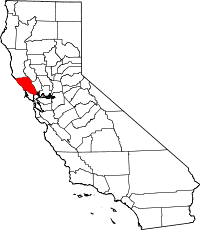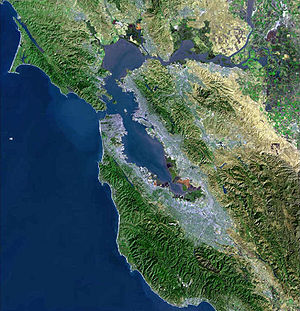Sonoma, California
| City of Sonoma | |
|---|---|
| — City — | |
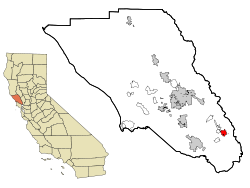 |
|
| Coordinates: | |
| Country | United States |
| State | California |
| County | Sonoma |
| Incorporated | September 3, 1883[1] |
| Government | |
| - Type | Council-manager |
| - Mayor | Ken Brown |
| - City Manager | Linda Kelly |
| Area[2] | |
| - Total | 2.65 sq mi (6.78 km2) |
| - Land | 2.65 sq mi (6.78 km2) |
| - Water | 0 sq mi (0 km2) 0% |
| Elevation[3] | 85 ft (26 m) |
| Population (2009)[2] | |
| - Total | 9,863 |
| - Density | 3,721.89/sq mi (1,453.86/km2) |
| Time zone | PST (UTC-8) |
| - Summer (DST) | PDT (UTC-7) |
| ZIP code | 95476 |
| Area code(s) | 707 |
| FIPS code | 06-72646 |
| GNIS feature ID | 277617 |
| Website | www.sonomacity.org |
Sonoma is a historically significant city in Sonoma Valley, Sonoma County, California, USA, surrounding its historic town plaza, a remnant of the town's Mexican colonial past. Sonoma today is a center of wine industry for the Sonoma Valley AVA Appellation, as well as the home of the nationally recognized Sonoma Valley Film Festival. Sonoma's population was 9,128 as of the 2000 census.[2] Sonoma was the capital of the short-lived California Republic.
Contents |
History
Origins
The region of Sonoma was originally the home of Native American Coast Miwok tribes as well as the Pomo people and Wintuns. Many of the Native Americans still remain, even after seven changes in government since the Spanish first explored and took over the region (see Sonoma County for governments.)
The town of Sonoma, El Pueblo de Sonoma, began with the Mission San Francisco Solano founded in 1823 by Father Joseph Altimira of Spain. This mission was the farthest north of all 21 California missions connected by a "Royal Road" called El Camino Real. The Mission San Francisco Solano was the sole California mission established under the rule of a newly-independent Mexico, and the last. Soon after it was built, it was secularized by the Mexican government, under the orders of Lieutenant, later General, Mariano Guadalupe Vallejo. Under Vallejo's supervision, the El Presidio de Sonoma, or Sonoma Barracks (part of Spain's Fourth Military District), was built beside the mission for the army, and he pursued control and order in the region over the native tribes and kept a military eye on the Russians of Fort Ross. Vallejo's relationship with the Native Americans of the region was helped by another resident of Sonoma, his friend and ally the native called Chief (Sem-Yeto) Solano of the Suisunes who had been baptized at the mission. Sonoma was also the first place in California to fly the "Bear Flag".
Plaza
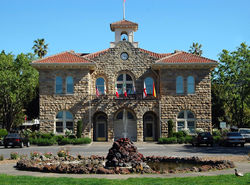
El Pueblo de Sonoma was laid out in the standard form of a Mexican town, centered around the largest plaza in California, 8 acres in size. This plaza is surrounded by many historical buildings, including the Mission San Francisco Solano, Captain Salvador Vallejo's Casa Grande, the Presidio of Sonoma, the Blue Wing Inn, the Sebastiani Theatre, and the Toscano Hotel. In the middle of the plaza, Sonoma's early 20th-century city hall, at the plaza's center and still in use, was designed and built with four identical sides in order not to offend the merchants on any one side of the plaza. The plaza is a National Historic Landmark and still serves as the town's focal point, hosting many community festivals and drawing tourists all year round. There are approximately thirty restaurants in the plaza area, including Italian, Irish, Mexican, Portuguese, Mediterranean, Himalayan, and French. It provides a central tourist attraction. It is also the location of the Farmer's Market, held every Tuesday evening from April to October.
American revolt against Mexican rule
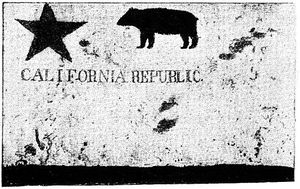
Sonoma is known as the birthplace of American California, for it was in this town plaza that the Bear Flag Revolt took place and a Bear Flag was first raised on June 14, 1846. The rebelling men claimed to act on the orders of Col. John C. Fremont proclaiming independence from Mexican rule and a free country called the California Republic here. Sonoma served as the capital of the short-lived California Republic until the United States Stars and Stripes flag was raised during the Mexican-American war.
General Vallejo was imprisoned during the Bear Flag Revolt of 1846, and he later transferred his allegiance to the U.S. and endorsed California statehood (1850). With his amassed land holdings, Vallejo guided the development of the town of Sonoma. He was one of the most powerful residents in the town's history, dividing up the lands into large ranches for friends and family.
Viticulture
Sonoma is also considered the birthplace of wine-making in California, dating back to the original vineyards of Mission San Francisco Solano, then improvements made by Agoston Haraszthy, the father of California viticulture and credited with introduction of the Zinfandel/Primitivo grape varietal. The Valley of the Moon Vintage Festival takes place late each September, and is California's oldest celebration of its winemaking heritage.
Geography
Sonoma is located at (38.288771, -122.458884)[4]. The city has an area of 2.65 sq mi (6.9 km2), none of it covered by water.[2]
The city is situated in the Sonoma Valley, with the Mayacamas Mountains to the east and the Sonoma Mountains to the west, with the prominent landform Sears Point to the southwest. The following areas are nearby:
- Sonoma County, California - Home County
- Napa County, California - East
- Marin County, California - South, South-West
- Solano County, California - South-East
- Mendocino County, California - North
- Lake County, California - North-East
- Pacific Ocean, United States - West
- San Pablo Bay, California - South
Climate
Sonoma has typical Mediterranean weather with hot, dry summers (although nights are comfortably cool) and cool, wet winters. In February, the normal high is 58.4 °F (14.7 °C) and the typical low is 37.3 °F (2.9 °C). In July, the normal high is 89.8 °F (32.1 °C) and the normal low is 51.9 °F (11.1 °C). There are an average of 58.1 days with highs of 90 °F (32 °C) or higher and 12.1 days with highs of 100 °F (38 °C). The highest temperature on record was 116 °F (47 °C) on July 13, 1972, and the lowest temperature was 13 °F (−11 °C) on December 22, 1990. Normal annual precipitation is 30.64 inches (778 mm). The wettest month on record was 20.29 inches (515 mm) in January 1995. The greatest 24-hour rainfall was 6.75 inches (171 mm) on January 4, 1982. There are an average of 68.6 days with measurable precipitation. Snow has rarely fallen, but 1.0 inch fell in January 1907; more recently, snow flurries were observed on February 5, 1976 and in the winter of 2001.[5]
Environmental features
The principal watercourse in the town is Sonoma Creek, which flows in a southerly direction to discharge ultimately to the Napa Sonoma Marsh; Arroyo Seco Creek is a tributary to Schell Creek with a confluence in the eastern portion of the town. The active Rodgers Fault lies to the west of Sonoma Creek; however, risk of major damage is mitigated by the fact that most of the soils beneath the city consist of a slight alluvial terrace underlain by strongly cemented sedimentary and volcanic rock.[6] To the immediate south, west and east are deeper rich, alluvial soils that support valuable agricultural cultivation. The mountain block to the north rises to 1,200 feet (366 m) and provides an important scenic backdrop, around whose views the city's original streetscape was carefully laid out.
In terms of fauna, there are a variety of birds, small mammals and amphibians who reside in Sonoma. California quail frequent the riparian areas, while black tailed deer kite, towhee, waxwing, robin, thrush and sparrow bird species are found locally.
The town of Sonoma boasts a relatively quiet setting, with California State Route 12 (called from north to south Sonoma Highway, West Napa Street, and Broadway), Fifth Street West, and Spain Street being the primary noise sources. About eight miles (13 km) south of the city is the Infineon Raceway, which is also a significant noise generator. The total citywide population exposed to environmental noise exceeding 60 CNEL is approximately 300.
Demographics
As of the latest census[2] of 2000, there were 9,128 people, 4,373 households, and 2,361 families residing in the city. The population density was 3,442/sq mi (1,330/km²). There were 4,671 housing units at an average density of 1,762/sq mi (681/km²). The racial makeup of the city was 93.80% White, 0.36% African American, 0.34% Native American, 1.70% Asian, 0.05% Pacific Islander, 1.61% from other races, and 2.14% from two or more races. 6.85% of the population were Hispanics (of any race).
There are 4,373 households of which 21.1% have children under the age of 18 living with them, 42.5% were married couples living together, 8.5% had a female householder with no husband present, and 46.0% were non-families. 39.2% of households consist of individuals and 21.5% have someone living alone who is 65 or older. The average household size was 2.07 and the average family size was 2.77. The age distribution is as follows: 18.6% under the age of 18, 4.8% from 18 to 24, 23.5% from 25 to 44, 28.9% from 45 to 64, and 24.2% who have achieved age 65. The median age is 47 years. For every 100 females there were 81.5 males. For every 100 females age 18 and over, there were 77.0 males.
The median income for a household in the city was $50,505, and the median income for a family was $65,600. Males had a median income of $51,831 versus $40,276 for females. The per capita income for the city was $32,387. 3.7% of the population and 2.0% of families were below the poverty line. 3.3% of those under 18 and 4.7% of those are 65 and older.
Politics
In the state legislature Sonoma is located in the 2nd Senate District, represented by Democrat Pat Wiggins, and in the 6th Assembly District, represented by Democrat Jared Huffman. Federally, Sonoma is located in California's 1st congressional district.
Media
There are two local newspapers in Sonoma; the Sonoma Index Tribune and the Sonoma Valley Sun.
The Sonoma Index-Tribune from Sonoma Valley Publishing, has been family owned since 1884. It was started by Benjamin Frank in 1879 as the "The Sonoma Index." In 1884, Harry Granice purchased the small weekly and it soon became "The Sonoma Index-Tribune." Today, the paper is still owned and operated by the same family line. Upon Granice's death, his daughter Celeste Granice Murphy took over the publication. In 1946, Robert M. Lynch joined his aunt in the newspaper business, eventually buying the paper from her. Today Robert Lynch's sons, Bill Lynch and Jim Lynch, serve as owners and publishers of the twice weekly publication. The same company also provides the quarterly SONOMA magazine. The newspaper has received dozens of awards in its history, including recognition from the National Newspaper Association and the California Newspaper Publishers Association.
The Sonoma Valley Sun is a weekly newspaper serving the city of Sonoma, California and surrounding communities since 2004 with news reporting, graphics, and photography. Its bimonthly companion insert, FineLife, is no longer published. The Sonoma Valley Sun formerly served the Latino community with El Sol, which is also no longer published. In 2010, publisher and owner Bill Hammett, a multimillionaire with ties to the telecom industry, sold the paper to a consortium of four freelancers after laying off his staff.
Transportation and highways
California State Route 12 is the main route in Sonoma, passing through the populated areas of the Sonoma Valley. California State Route 121 is to the south, and passes through the unincorporated area of Schellville.
Notable residents
Joseph Hooker, one-time politician and future American Civil War general, lived in Sonoma in the 1850s. His house still exists in town.
Jack London: (1876-1916) claimed that Sonoma meant "The Valley of the Moon", which phrase is still applied to the town as well as the whole of Sonoma Valley. The writer lived for many years in the nearby town of Glen Ellen.
Mariano Guadalupe Vallejo: Last Mexican military commander of northern California. His residence in Sonoma was the site for a portion of the Bear Flag revolt which made California a Republic.
Count Agoston Haraszthy: the father of California viticulture, created the first winery west of the Mississippi. He tried many locations (including Wisconsin!) but settled in Sonoma with General Vallejo's assistance. His first winery, Buena Vista, still exists today.
General Hap Arnold: an aviation pioneer and commander of the United States Army Air Corps (from 1938), commander of the U.S. Army Air Forces (from 1941 until 1945) and the first General of the Air Force (in 1949). The main arterial road, Arnold Drive, the runs up the west side of Sonoma Valley, is named for him as for Arnold Field a Football Field in Downtown Sonoma
John Lasseter: (born January 12, 1957 in Hollywood, California) is an animator and the chief creative executive at Pixar Animation Studios. Lasseter won Academy Awards for Best Animated Short Film (Tin Toy) and Special Achievement Award (Toy Story).
Daedalus Howell: (born July 19, 1972 in Petaluma, California, is a media personality and entertainment mogul who transplanted to Sonoma in 2005. He has written hundreds of columns about the Sonoma experience and has produced dozens of Sonoma-themed short films.
Chuck Williams: founder of Williams-Sonoma, the food assessory chain store, started its existence on Broadway, two blocks from the Plaza, before moving to San Francisco.
Sebastiani Family: Family patriarch, Samuele Sebastiani, started Sebastiani Vineyards in 1904. His son, August, ran the company from 1944 to the late 1970s, when his son Sam took the reins. August died in 1980. In 1986, August's youngest son, Don Sebastiani, took the company from about 200,000 cases to just shy of 8 million cases produced in 1999, at which time he sold a number of assets to Constellation Wines. Don then left the old family company and he, along with his sons, Donny & August, started Don Sebastiani & Sons in 2000. Sebastiani Vineyards was under the direction of Sam & Don's sister, Mary Ann Sbastiani Cuneo, before being sold in Foley Wine Group in 2008. Don's son, August Sebastiani, was elected to the Sonoma City Council in 2006.
Robin Williams: (born July 21, 1952 in Chicago) famous actor and comedian.
Brian Posehn: Comedian and co-star on The Sarah Silverman Program grew up in Sonoma.
Professional athletes: Tommy Everidge, Tony Moll and Joe Abouata were classmates, and grew up in Sonoma.
Other topics
Historic sites
Sonoma can boast three of the first ten California Historical Landmarks:
- Mission San Francisco Solano (#3) - On July 4, 1823, Padre José Altamira founded the northernmost of California's Franciscan missions here, the only one established in California under independent Mexico.
- The home of General Mariano Guadalupe Vallejo (#4) - known as Lachryma Montis (Tears of the Mountain), was built in 1850.
- Bear Flag Monument (#7) - On June 14, 1846, the Bear Flag Party raised the Bear Flag in the Sonoma plaza and declared California free from Mexican rule.
- The Presidio of Sonoma, the northernmost Mexican military post, still stands facing the plaza.
- The Plat: A overlook that provides a wonderful view of the town and a popular place for Sonoma teen to host outdoor keggers.
Items named after the town
- Sonoma Jack Cheese: Cheese, moist to very dry light colored cheese covered in chocolate powder and most credited to the Vella cheese making family. The Vella Cheese factory, former Sonoma Brewing Co. building, continues to make a variety of cheese products and is within walking distance of the Plaza.
- The GMC Sonoma was a compact pickup truck.
- Intel's "Sonoma" series processors. Several of Intel's processors were given names from towns, cities or places in Sonoma County when Intel's CEO was Les Vadasz. He is a resident of the Valley of the Moon area.
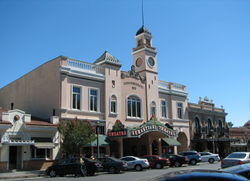
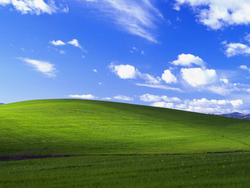
Points of interest
- Agua Caliente
- The Valley of the Moon
- Sonoma Creek
- Arroyo Seco Creek
- Jack London State Historic Park
- Quarryhill Botanic Garden
- Sonoma Valley
- Sonoma Developmental Center
- Cornerstone Sonoma Internationally acclaimed garden installations created by world class landscape architects from around the world. Plus, shops, art galleries, a cafe, and wine tasting.
- Buena Vista Winery
- Wine Country
- Sonoma Traintown Railroad - a quarter scale train in a park 1-mile (1.6 km) south of the Town Square that covers 10 acres. It has a petting zoo, ferris wheel, swings, vintage carousel, scrambler, miniature coaster and an airplane ride. Train Town has claimed to be one fifth the size of the original Disneyland. It was opened in 1968. The airplane ride is only for children that are 54 inches tall or shorter, so it does have a height restriction.
- Sonoma Plaza
- Blue Wing Inn of 1840, where such notable guests, according to local tradition, included John C. Frémont, U. S. Grant, Governor Pío Pico, Kit Carson, Fighting Joe Hooker, William T. Sherman, Phil Sheridan, and members of the Bear Flag Party.
- General Mariano Guadalupe Vallejo Home: official residence of the last Mexican Governor.
- Presidio of Sonoma adobe
- Mission San Francisco Solano, California's last Mission
- Swiss Hotel - adobe structure and original home of Vallejo's brother, located on The Plaza.
- Sebastiani Theatre - a historical theatre built in 1933 by Samuele Sebastiani as a movie house.
- Infineon Raceway
- The Sonoma Overlook Trail
- Microsoft Windows Bliss (image) was photographed southeast of town on Fremont Drive near the site of Stornetta's Dairy.
References
- ↑ "Dates of incorporation". http://www.cacities.org/resource_files/20457.IncorpDateLO.doc. Retrieved 2008-07-11.
- ↑ 2.0 2.1 2.2 2.3 2.4 "American FactFinder". United States Census Bureau. http://factfinder.census.gov. Retrieved 2008-01-31.
- ↑ U.S. Geological Survey Geographic Names Information System: Sonoma
- ↑ "US Gazetteer files: 2000 and 1990". United States Census Bureau. 2005-05-03. http://www.census.gov/geo/www/gazetteer/gazette.html. Retrieved 2008-01-31.
- ↑ National Climatic Center (www.ggweather.com)
- ↑ General Plan, City of Sonoma, California, prepared for the City of Sonoma by Hall and Goodhue Community Design Group, San Francisco, Ca. (1974)
External links
- City of Sonoma website
- The Sonoma Index-Tribune
- The Sonoma Valley Sun
- El Sol Sonoma
- KSVY 91.3 Sonoma
- SVTV 27 Sonoma
- Sonoma Valley Film Festival
- Sonoma Valley Visitor's Bureau Website
- Official site of the Valley of the Moon Vintage Festival
- Official site of the Sonoma Valley Olive Festival
- Sonoma County Vintners Association Web Site
- Sonoma Valley Vintners and Growers Alliance
- National Park Service article on Sonoma Plaza
- Sonoma Parks and Recreation Site
|
|||||||||||||||||
|
|||||||||||||||||||||||||
